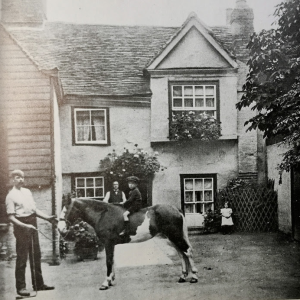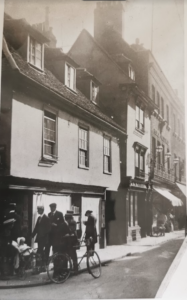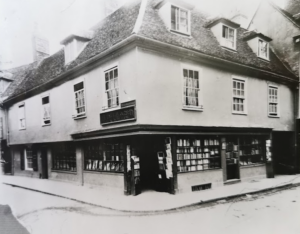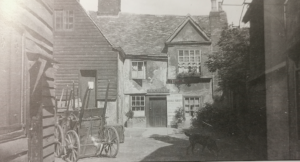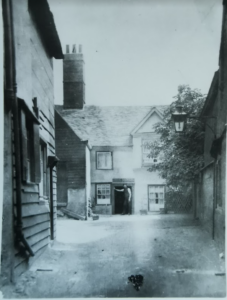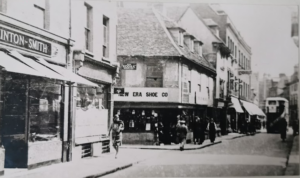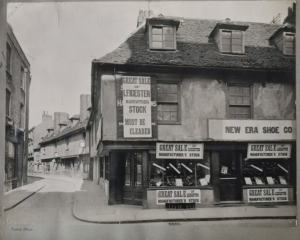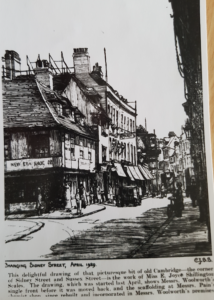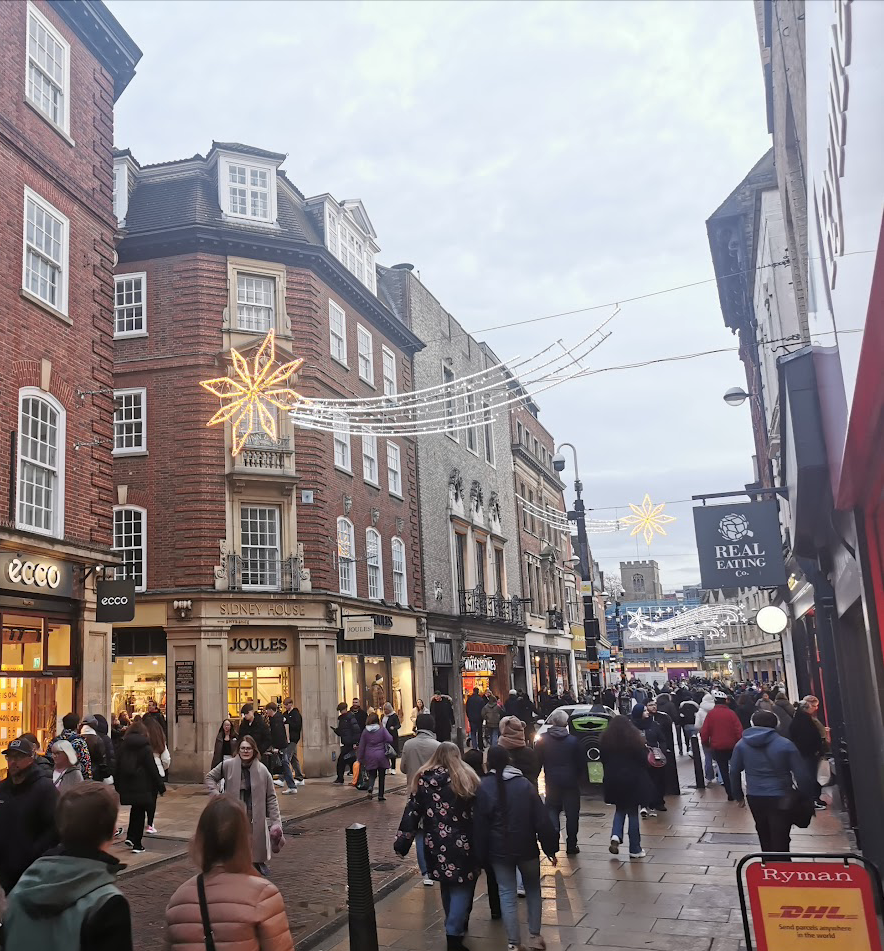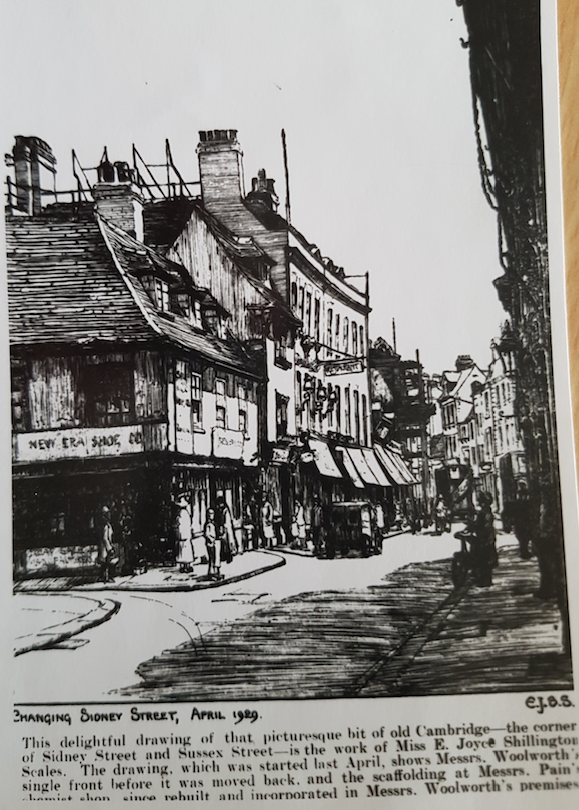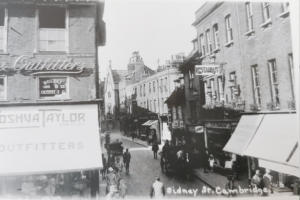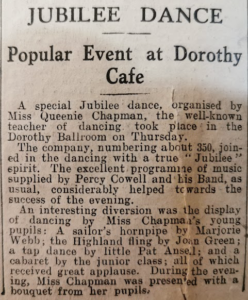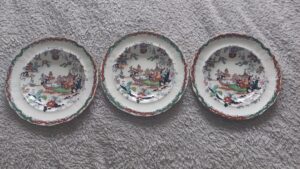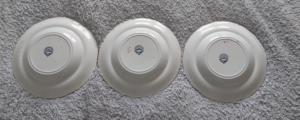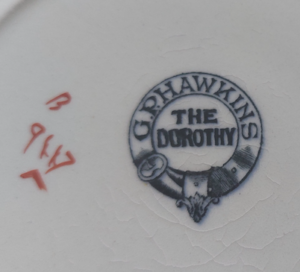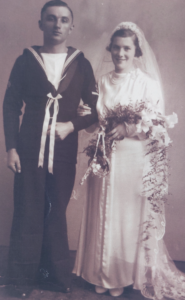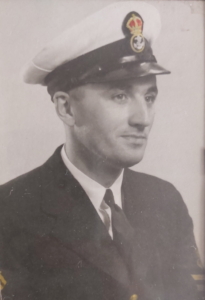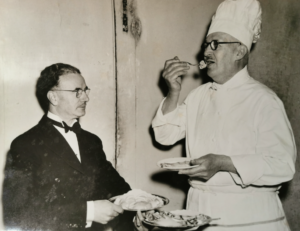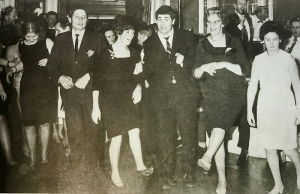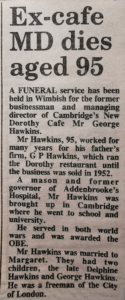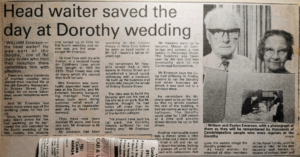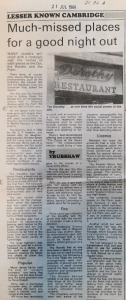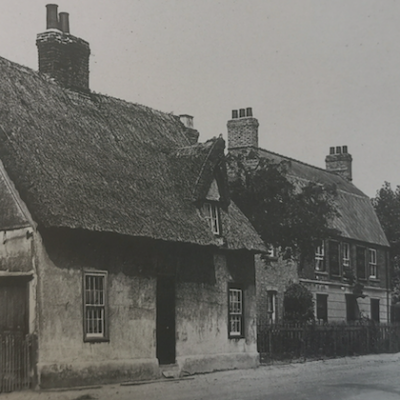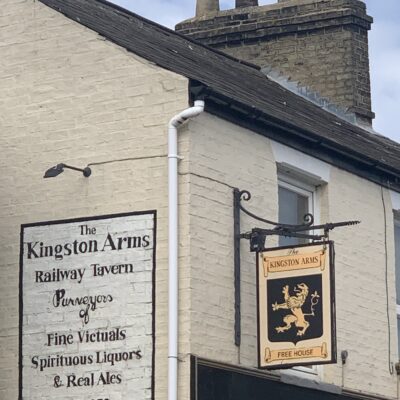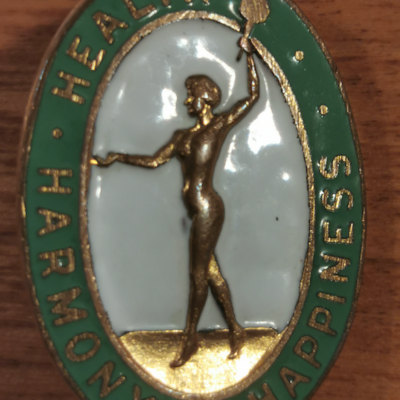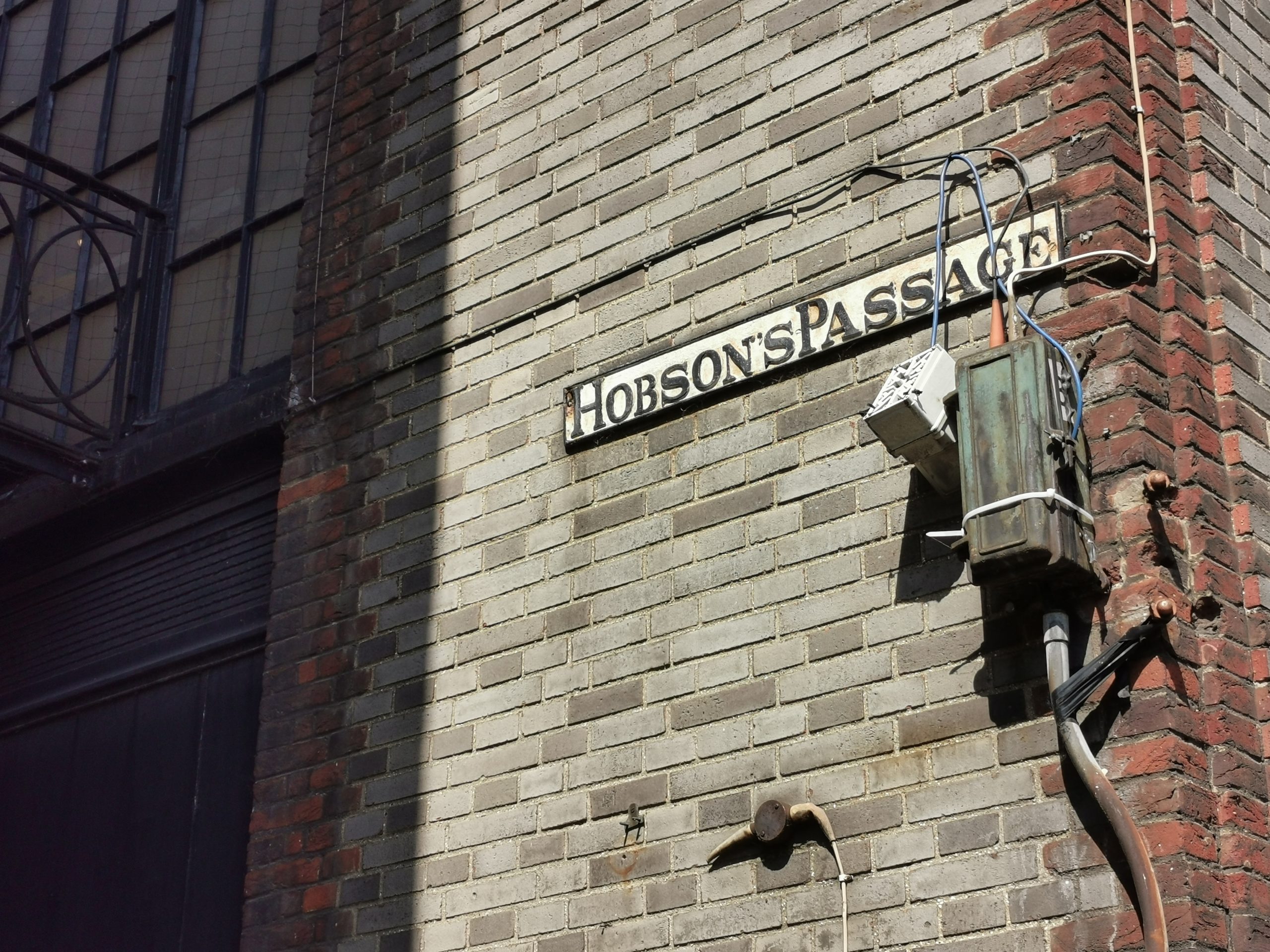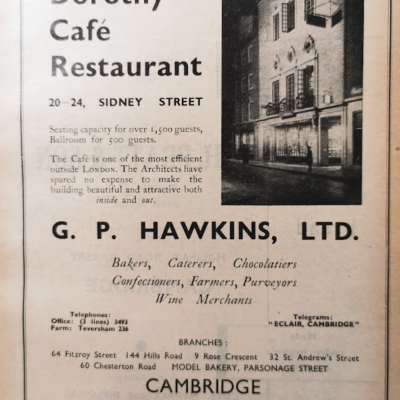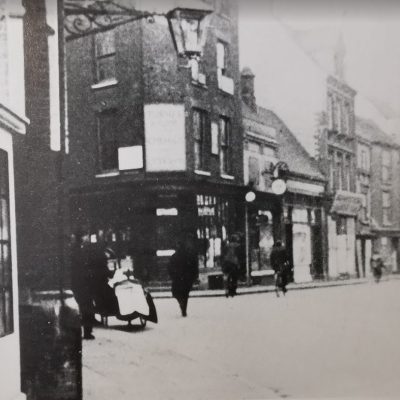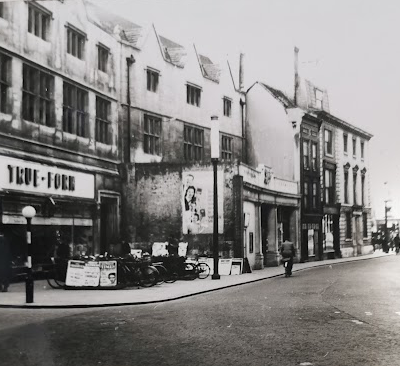Search by topic
- archaeology
- Building of Local Interest
- charity
- church
- crime
- dressmaker
- fire
- Great Eastern Railway
- Listed building
- Mapping Relief
- medieval
- oral history
- poverty
- Public House
- Rattee & Kett
- Religious House
- Roman
- scholar
- school
- Then and Now
- tudor
- women
- work
- world war one
- world war two
Search by text
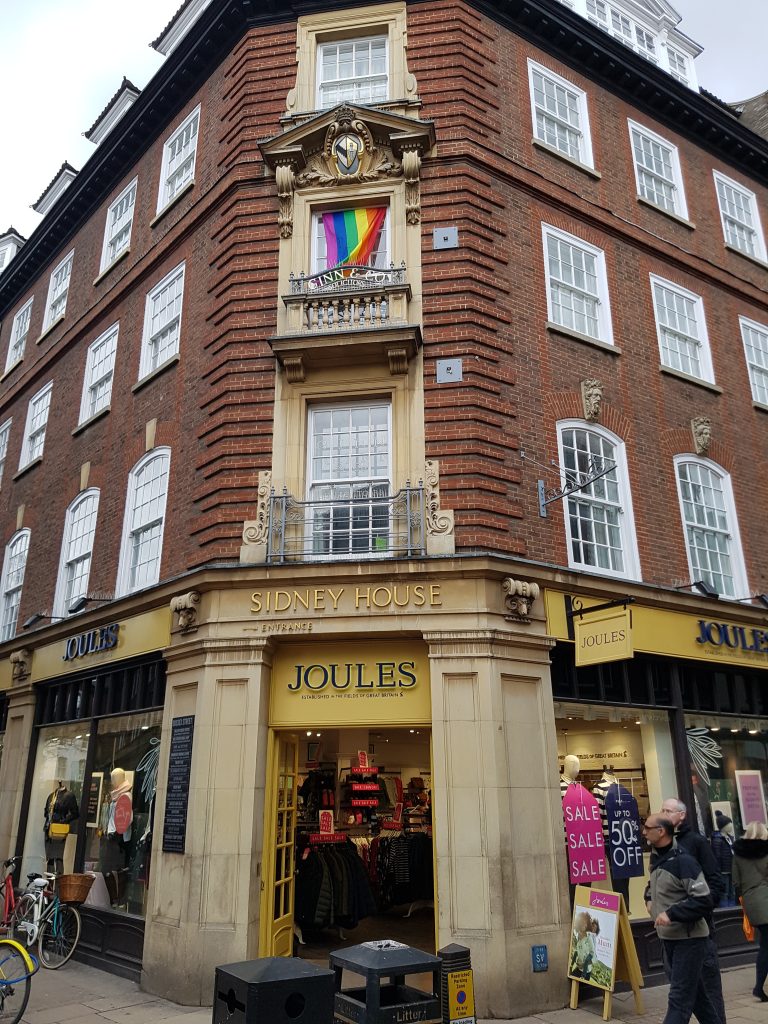
23 – 24 Sidney Street, Lord Nelson, True Blue Inn, Sidney House, The Dorothy Cafe
History of 23 - 24 Sidney Street
True Blue Inn was probably built towards the end of the sixteenth century and contained a good deal of Jacobean carving. The Wallis family had been booksellers since 1760.
1851
(24) Henry Wallis, 53, bookseller, b Cambridge
Alice, 45, b Landbeach
Henry William, 22, bookseller, b Cambridge
Louisa Jane, 20,b Cambridge
Lydia White, servant, 34, b Landbeach
Elizabeth Adams, 85, nurse, b Longstanton
1861
(23) Lord Nelson
William Weight, 51, publican, b Mepal
(24)
Henry Wallis, 63, bookseller and stationer, b Cambridge
1901: True Blue
James Gould, 59, publican, b Essex
Eliza, 58, b Essex
Ernest, 18, manager of premises, b London
[In 1911 the couple were at 16 Gloucester Street]
1913
(23) Ben Clark, True Blue
(24) B Diver & son (late H W Wallis) new and second-hand booksellers and stationers
Benjamin Diver
Edward Beldam Diver, Lieutenant Cambs. Volunteer Fire Brigade
1919
(24) bookshop closed
1920s:
(23) A E Whitehead, fruiterer
(24) New Era Shoe Company
1925
Woolworth open in Sidney Street
1926
1929
The drawing above shows the front of Woolworths at 22 Sidney Street before it was pulled back.
1929 27th April: Cambridge Chronicle
Cambridge to have a modern caravanserie matched the modern splendours of Oxford St & Regent street where a thousand people may dine without strain on the service & dance too if they are so minded, a place of dignity & comfort & of surpassing resource. The old Dorothy cafe is to disappear – not so very old though as a modern restaurant – & a building of 3 storeys spanning space between Sidney St & Hobson street. Ground floor entrance Sidney St is shop & showroom & on eastern side a dining hall or restaurant. Principal staircase to first floor will be from hall at Hobson street entrance & access to a dance hall with black hornbeam floor on springs. This accommodation for 320 diners at a public banquet but specially prepared for dancing for 450 at once. At western end another dining hall. Another on second floor, seat 80, suitable private dinner of clubs & organisations, perhaps this will be the oak room which intention of Hawkins to decorate; also roof garden looking across to gardens of Christ’s college. Nags Head inn will not disappear but be given place in the basement. Will take 18 months but Hobson St side will be completed before start made with Sidney St front to ensure restaurant open throughout.
1930
G P Hawkins’ Dorothy Cafe opened at 20-21 Sidney Street 1901-1904. It expanded into no. 22 in 1919 and then nos. 23 and 24 in 1930.
30th Oct: Cambridge Chronicle
A labourer engaged in excavation work at the new Dorothy Cafe was killed, and another seriously injured. The men, who were employed by Coulson and Sons, were clearing the old brickwork and masonry under Hobson’s Passage when a considerable mass of brickwork gave way without warning and they were smothered in the ruins. The ambulance was sent for and a crowd quickly gathered. The police had some difficulty in controlling the traffic, owing to its density at one time.
1931
3rd April: Cambridge Chronicle
G.P. Hawkins opened the first tea shop in Cambridge at the corner of Sussex Street in 1900. It could hold 10 people with a waitress & two assistants. As adjoining space became available the premises
were enlarged. Today the Dorothy Cafe can accommodate 2,000 and there is no brand of catering which cannot be undertaken. In 1904 he erected a bakery with two ovens at the side of Midsummer
Common; today with seven ovens working six days a week he produces about 200,000 loaves. It also manufactures a ton of ice a day plus sufficient ice cream to supply the entire needs of Cambridge.
15th July: Cambridge Chronicle
Dorothy cafe reopens after redevelopment; barrel roof of Banquet Hall & vaulted ceilings of restaurant are unique; part of basement Prince of Wales hotel; first floor restaurant where Percy Cowell & his players are daily delighting a host of people; shop sells confectionery, sweets & cold cooked meats, fruit, flowers … on Sundays 5,000 pass through cafe, shop & restaurant; in Oak room some of original oak panelling from old building preserved; two smaller rooms known- as Hobson room & Cromwell room.
11th December: Cambridge Chronicle
G.P. Hawkins occupied a unique place in Cambridge life. Few men are twice Mayor and play such a part in the political and business life of the town. He opened Cambridge’s first tea shop and later the Dorothy Cafe which can easily accommodate 2,000 people at one time. In the bakehouse in Parsonage Street tributes fell like water from the lips of the employees and 1,400 crowded into the church for his funeral.
1932
1934 19th June: Cambridge Chronicle
An agreement has been reached in the long-running dispute over the rebuilding of the Dorothy Cafe in Sidney Street. In spite of the conflict over details Messrs G.P. Hawkins now have a really beautiful, modern and commodious building that has earned praise from the Cambridge Preservation Society and the Illumination Congress while the builders are no longer under any imputation of incompetence
29/10/1938 Fireworks, jeers, cheers and shouts punctuated a meeting organised by the University Socialist Club addressed by Major[?][Clement] Atlee, the Leader of the Opposition, in the Corn Exchange. The noise died down when he began to speak but there were frequent interruptions caused by exploding fireworks. All police leave was cancelled because of the meeting and a visit by Sir Oswald Mosley to the C.U. Fascist Association dinner in the Dorothy Cafe. But rowdyism was principally of the vocal kind. (Cam.News)
1940s:
In 2022 CR sent an email with photos of plates used at the Dorothy.
She writes: I have just been on phone to my mother and aunt trying to see a connection with Cambridge and what we can remember regarding these plates. My grandparents married in 1939. Their names were Edward Lewis & Edna Bamber and he was in the navy were he served on a few ships. The last couple were The Prince of Wales and the Repulse. He became Captain Yeoman of signals , then got torpedoed inWWII; he was one of the lucky survivors. He then gave up the navy and worked as a youth club member in Evesham till he died in 1967. My mother remembers he loved going to antiques fairs and shops so this is probably where he got them , One connection to Cambridge is that my nan’s sister Vera went to Cambridge and was in the WAAFs. So they must have gone to visit her and Edward would have gone round local antique shops in the 1940s. So at this time some old stock of the Dorothy may have been there where he picked them up.
1951 22 September: Cambridge Chronicle
The retirement of Mr A.V. Williams after nearly 25 years’ service with Messrs G.P. Hawkins means a loss of a familiar figure at the Dorothy Cafe. He has waited upon many celebrities, including film and radio stars Freddie Grisewood, Wilfred Pickles, Jessie Matthews, Richard Murdoch and Kenneth Home and Don Bradman’s Australian Cricket Team in 1938. A pre-war recollection is of Sir Oswald Mosley and William Joyce (remembered later as “Lord Haw Haw” on the Gemian radio). On one occasion Joyce deputised at a Fascist meeting for Mosley, whom the Proctors had advised not to come to Cambridge, and the basement at the Dorothy was filled with police – just in case!
1952 17th November: Cambridge Chronicle
Mr George Hawkins, who has been the sole owner of G.P. Hawkins Ltd has announced that he has disposed of his entire shareholding to the Cambridge Co-operative Society. The firm was founded in 1838 in Fitzroy Street, which is still one of their shops. At the beginning of the century the late Mr G.P. Hawkins opened a shop and cafe in Sidney Street. In 1929 these premises and the adjoining site were extensively developed resulting in the opening in 1931 of‘The Dorothy’ as it stands today.
1952 22nd November: Cambridge Chronicle
Mr George Hawkins has disposed of his holdings in the firm of G.P. Hawkins Ltd to the Cambridge Co-operative Society and a new company has been formed. But he has insisted that ‘The Dorothy’ will continue on the same lines as in the past and did not agree to the change-over until given that assurance. Running a catering establishment of this size is no easy task, made greater during the war when he was also the Regional Bread Officer for the Ministry of Food.
1957 15th October: Cambridge Chronicle
Firemen called to the Dorothy Cafe took one look at the amount of smoke pouring from the upper floor windows and immediately sent for reinforcements. The fire started under a sideboard in the second floor Oak Room and flames spread up the walls to the ceiling, damaging the floor of the Cromwell Room above. But business carried on as usual and management say they will honour all obligations. The usual dances will be held.
1962
(22-23) Dorothy Cafe & Restaurant
Sidney House contained the offices of a number of firms of solicitors
1967
This photo shows some of the 1,100 employees and guests who attended the Cambridge and District Co-operative Society’s staff party.
1972
The Dorothy in Cambridge has been sold. A new role for the city’s best-known catering and dancing centre has not been decided by the new owners, but may include a “quality” department store. The Dorothy’s present owners, G.P. Hawkins ltd said that parking restrictions have hit the firm’s business. The Dorothy contains a supermarket, restaurant, large ballroom and other rooms used by many organisations for official functions (CEN 21.4.1972)
A collection of Cambridge nostalgia went under the hammer as the fixtures and fittings of the Old Dorothy restaurant and ballroom were auctioned. “The Dot” as it was affectionately known to Saturday night dancers down the years was a mecca of weddings, parties, dinners and thousands of personal memories. It was a child of the tea dance and potted palms of the 1920s and survived the Second World War to outlive nearly all its contemporaries. It closed its doors to the public in August
and now its future is uncertain. Today it looked drab and tattered with mirrors, lights and other fittings ripped from the walls. About 150 attended the auction but many were only there to pay their last
respects. (CEN 28.9.1972)
See Janet Haggar interview
1977 2nd Feb.: CEN
The Dorothy Continental delicatessen on the corner of Sussex Street, Cambridge, ceased trading at the weekend. It was the last remaining part of the former Dorothy restaurant and ballroom, sold by G.P. Hawkins in 1972 for £850,000. The Dorothy contained a supermarket, restaurant, large ballroom and other rooms used by many organisations for official functions. It was taken over by the Co-op in 1952. The above-ground part of the Dorothy was acquired by Waring and Gillow, the London-based
furniture chain, the remainder now forms the Henekey Tavern. When the Dorothy closed, Hawkins moved its outside catering section to the Alma Brewery site in Russell Street. G.P. Hawkins (Co-op) said new lease rent increase makes business unviable so Sidney Sussex lease to Wimpy International
George Hawkins was living at 11, Chaucer Road in 1939.
1988
1989
13th July CEN
The Dorothy was the social centre of Cambridge for many years, a place where town met gown and people enjoyed the regular afternoon dances. During the 50s its Blue Room became a major attraction for the young with rows of motor bikes and scooters lined up outside. Its oyster and fish restaurant opened in 1965 with an air-conditioning unit wafting away fishy odours and meals were cooked at the tables, under customer’s noses Now the property’s owner, Dillons Bookshop has leased part of the
Sidney Street building to Festival Catering and the building has been reborn with a teashop, pub, restaurant and function room.
29th September CEN
Dorothy restaurant that reopened 12 weeks ago goes into receivership after refit debts -rebuilding costs over by 100%, to sell as going concern
1990 27th June:
Dorothy restaurant and bar closed ending bid to revive and modern it. Was put up for sale last autumn, one month after reopening, but failed. Cambridge Jazz Club will need new venue –
2018
Joules, clothes shop
[some newspaper extracts located by Mike Petty]
Contribute
Do you have any information about the people or places in this article? If so, then please let us know using the Contact page or by emailing capturingcambridge@
License
This work is licensed under CC BY-NC-SA 4.0





